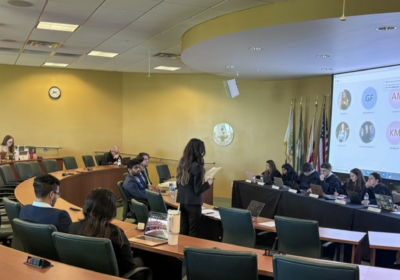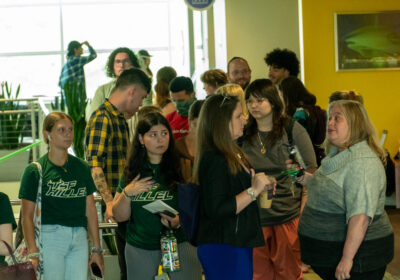‘Freedom’ in photographs
Tying into USF’s 25th annual Martin Luther King Jr. Commemorative Celebration and the upcoming Black History Month, a Marshall Student Center (MSC) Centre Gallery exhibition offers a new look on the 1963 March on Washington.
The “And Freedom for All: The March on Washington for Jobs and Freedom” exhibit, which ends Friday, features 48 unpublished photographs from the archives of LOOK magazine photographer Stanley Tretick.
Assistant Director of the Office of Multicultural Affairs Stacy Koshko said the office sponsored the exhibition, which was organized by ArtVision Exhibitions.
“I found the exhibit online and met with the owner of the estate, a wonderful woman,” Koshko said. “It really fit the theme of our week.”
One photo depicts former President John F. Kennedy with Rabbi Joachim Prinz, civil rights leader A. Philip Randolph, then-Vice President Lyndon B. Johnson and former President of the United Automobile Workers Walter Reuther. Beside the photo, a card reads, “Mr. President, the black masses are restless and we are going to march on Washington.”
Labor leader and civil rights activist Randolph made that statement when proposing a march on the Capitol in June 1963. He is smiling in the picture as he stands beside some of the most powerful men in America at the time
According to NPR, the march was expected to be a picnic in the park by younger blacks, while older blacks expected it might end in violence. What no one saw coming were the 250,000 demonstrators that showed up to support the civil rights movement.
On the steps of the Lincoln Memorial, King delivered his “I Have a Dream” address. The speech was supposed to have a four-minute time limit, but ended up lasting more than 16 minutes.
Tretick stood among the awed listeners and snapped pictures that would become a statement for the civil rights movement in the 1960s.
Jefthah Filsaime, a freshman majoring in political science, said the March on Washington and King’s participation has remained relevant.
“The March on Washingtonwas one of the biggest differences made when it came to the way African-Americans were treated in America,” Filsaime said. “Martin Luther King was great, and what he stood for was great. He taught us not to respond with violence, but with the kindness of our hearts.”
Another one of Tretick’s photos depicts King walking forward, with a sign behind him reading “Jobs For All Now!” His expression is intent, serious and hopeful.
Students walking through the gallery during Tuesday’s reception stood silent before the photos – among ones that displayed Kennedy talking with King and people dipping their feet in the Lincoln Memorial’s reflecting pool.
West Miraglia, a sophomore majoring in psychology, said the exhibition offered a good portrait of the nearly 48-year-old demonstration.
“This exhibit gives you a really good understandingof the oppression that African-Americans had to encounter during the time period,” Miraglia said. “The exhibit brings to light what they went through.”






